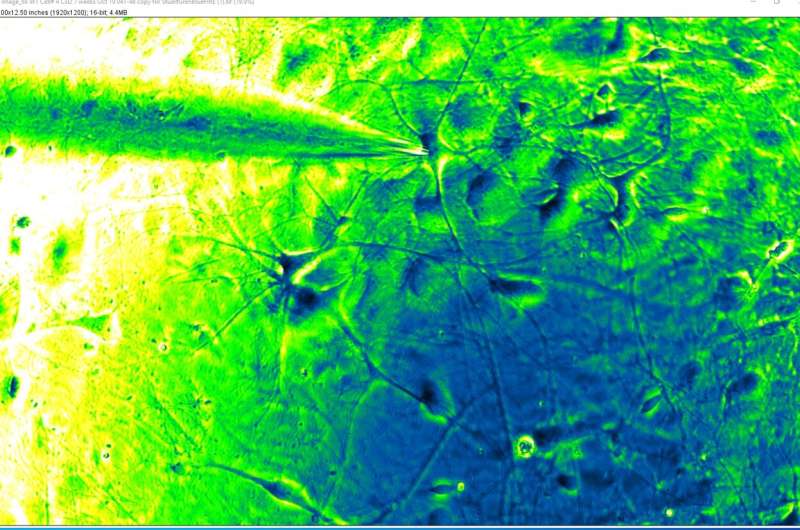This article has been reviewed according to Science X's editorial process and policies. Editors have highlighted the following attributes while ensuring the content's credibility:
fact-checked
peer-reviewed publication
trusted source
proofread
Scientists uncover new molecular drivers of Alzheimer's

According to the US Centers for Disease Control and Prevention, at least 5.8 million Americans are currently living with Alzheimer's disease, which is the most common form of dementia. There is no cure for Alzheimer's, in part because scientists do not yet have a full understanding of what causes the disease. But a new study from Scripps Research is shedding light on the molecular drivers that could contribute to Alzheimer's progression.
In the study, published in Advanced Science, the researchers used a new technique for studying single, living brain cells affected by Alzheimer's disease. By measuring the electrical activity of single neurons and the protein levels within those neurons, the scientists discovered new molecules linked to Alzheimer's. The hope is these molecules could be targeted by drugs to treat or slow the progression of the neurodegenerative disease in the future.
Close collaboration among Scripps Research's professors, including clinical neurologist Stuart Lipton, MD, Ph.D., protein expert John Yates, III, Ph.D., and bioinformaticist Nicholas Schork, Ph.D., (who is also the deputy director and distinguished professor of quantitative medicine at The Translational Genomics Research Institute, or TGen) enabled the scientists to develop this biotechnology feat.
"It was mind-boggling to me that we could take one cell, measure its electrical activity on the order of one-millionth of one-millionth of an ampere, and then look at thousands of proteins within that same cell to allow us to find the proteins that drive Alzheimer's-related abnormal electrical activity," says senior author Lipton, who is also the Step Family Foundation Endowed Professor and co-director of the Neurodegeneration New Medicines Center at Scripps Research. "But the beauty of this method is that it lets us uncover novel targets for Alzheimer's disease and related dementias."
Previous research by Lipton and others has shown that certain neurons become overactive in the brains of people with Alzheimer's, sending electrical signals that are stronger or more frequent than usual. Evidence suggests that this overactivity (also known as hyperexcitability) contributes to the cognitive decline associated with Alzheimer's.
In the new work, Lipton and colleagues developed a system in which scientists can take precise measurements of individual brain cells and then compare those affected by Alzheimer's with healthy cells. Lipton's group, which has previously developed methods for precisely measuring the electrical activity of neurons, teamed up with Yates to use mass spectrometry to identify levels of over 2,250 proteins in each nerve cell. Mass spectrometry can identify and quantify proteins from cells, but these analyses have traditionally been done on bulk collections of cells. Recent advances are permitting measurements at the single-cell level.
In the new system, known as single cell (sc)Patch-Clamp/Proteomics, a tiny glass tube filled with a salt solution is used as an electrode to measure the electrical activity of a cell, and then extract the cell for protein studies with mass spectrometry.
"This approach allows us to connect perturbations of electrical functions to molecular events in neurons, which is an exciting application of proteomics," says Yates.
The scientists analyzed the electrical patterns and protein levels of about 150 neurons and then used computational tools—applied by Schork—to find associations between hyperexcitability and abnormal protein levels. They pinpointed nearly 50 proteins that were present at higher or lower levels in hyperexcitable Alzheimer's cells compared to healthy cells.
"Some of these proteins were already known to be associated with Alzheimer's, but many were not," says Lipton.
The proteins were involved in many diverse functions of neurons, including control of electrons in free radicals (redox modulators), energy metabolism and inflammation. Fifteen of the proteins stood out as having particularly high or low levels in Alzheimer's neurons, and Lipton's group is planning follow-up studies on some of these molecules.
He also plans to expand the use of scPatch-Clamp/Proteomics for drug screens—testing whether potential Alzheimer's drugs fix both the hyperexcitability of neurons and the abnormal protein levels. He is correlating these findings with experiments on larger groups of brain cells obtained from patients with Alzheimer's known as cerebral organoids, or "mini-brains."
"One cell doesn't always tell the whole story," Lipton explains. "Some of the dysfunction in Alzheimer's has to do with how cells interact with each other, so if we can repeat this kind of study in a mini-brain organoid, we may make additional discoveries."
Lipton notes this method could be applied to drug discovery efforts for additional brain-related diseases.
"This new approach to personalized medicine—based upon protein expression and electrical activity of a single Alzheimer's neuron—could revolutionize drug discovery not only for this disease but other neurological diseases, which has lagged far behind other therapeutic areas," he adds.
In addition to Lipton and Yates, authors of the study are Swagata Ghatak, Jolene K. Diedrich, Maria Talantova, Henry Scott, Meetal Sharma and Matthew Albertolle of Scripps Research; and Nivedita Bhadra and Nicholas J. Schork of The Translational Genomics Research Institute (Professor Schork has a co-appointment at Scripps Research).
More information: Swagata Ghatak et al, Single‐Cell Patch‐Clamp/Proteomics of Human Alzheimer's Disease iPSC‐Derived Excitatory Neurons Versus Isogenic Wild‐Type Controls Suggests Novel Causation and Therapeutic Targets, Advanced Science (2024). DOI: 10.1002/advs.202400545



















